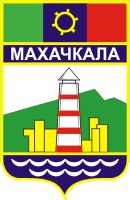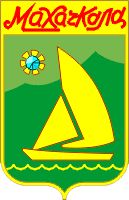Makhachkala
MAKHACHKALA (Махачкала)
Federal subject : Dagestan
Official blazon
В червленом поле на лазоревой узкой оконечности, ограниченной в виде бегущих вправо волн, - серебряная крепость в виде трех зубчатых башен, соединенных такими же стенами; средняя башня - широкая, одноярусная с зеленой сквозной аркой ворот, боковые - узкие, двухъярусные, с золотыми пламенами наверху; в арке - вензелевое имя Петра Великого; во главе крепость сопровождена солярным знаком в виде звезды с шестнадцатью усеченными лучами, загнутыми по ходу солнца.
Щит увенчан золотой башенной короной о пяти видимых зубцах, дополненной того же металла обручем, украшенным дагестанским национальным (кубачинским) орнаментом и имеющим рельефные бортики в виде витого шнура.
Щитодержатели, обращенные к щиту и обернувшиеся золотые орлы с воздетыми и распростертыми крыльями, сидящие на скрещенных серебряных якорях, оплетенных зелеными виноградными лозами с лазоревой гроздью посередине.
Origin/meaning
The arms were granted on December 15, 2006.
The castle is a canting element, kala meaning fortress. Historically there has been a fortress in the are for several centuries. The fortress itself has a trapezoidal base, hinting at the outline of the Tarki-Tau mountain (which is also similar to a trapezium) near the city.
The flames above the fortress symbolise the lighthouse function, which is derived from the previous arms of the city (see below).
The monogramme of Peter I in the gate refers to the historic name of the city - Port Petrovsk. "During the Persian campaign on August 12, 1722, Peter I camped at Tarkov five versts from the residence of Kumyk proprietor Shamkhal Adil-Gerei Tarkovsky. On the third day the tsar served a liturgy in the marching church of the Preobrazhensky regiment and placed a stone beside it." This stone developed into the city of Port-Petrovsk, which became a city in 1857. The base also indicates the harbour.
The solar disk above the castle is traditionally used by the peoples of Dagestan as a symbol of the sun. Sun symbols already appear on the Neolithic rock paintings in Dagestan. They are also found on products and objects of the Bronze and Iron Ages, and are widely represented in medieval monuments.
The crown over the shield is recommended by the Heraldic Council under the President of the Russian Federation for the capitals of the subjects of the Russian Federation, as the main sign of the status of the city district - the capital of the subject. In this case, the crown is decorated with Dagestan (Kubachin) ornaments, emphasizes that it is the emblem of the capital of the Republic of Dagestan.
The eagles with outstretched wings are figures from the emblem of the Republic of Dagestan, indicate that the city is the capital of Dagestan
The crossed anchors indicate the port status of the seaside city. In the history of Makhachkala, the construction of an artificial sea harbor, which made Petrovsk an important transport hub, had a great influence on the formation and further development of the city. The Makhachkala seaport today is the most southerly and ice-free port of Russia in the Caspian Sea with international communications links.
The grapevine symbolizes the diversity of people of representatives of different peoples and nationalities inhabiting the city.
The arms replaced the former arms, adopted on July 18, 1988.
The arms show the local lighthouse in front of a city and in chief a symbol for industry in the colours of the flag of Dagestan.
During Soviet times also the following 'arms' was used on a souvenir pin:
Contact and Support
Partners:
Your logo here ?
Contact us
© since 1995, Heraldry of the World, Ralf Hartemink 
Index of the site
Literature : Images from http://www.heraldicum.ru












